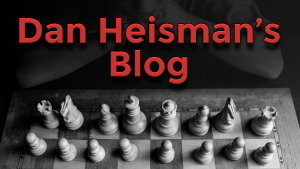Q&A with Coach Heisman Aug 8, 2014
"If you had to pick only one legacy to leave to the chess world, what would it be?"
Well, I have long given up on any hopes of my campaign to de-emphasize the wonderfully accurate but humanly over-dependent rating system (see Encouraging Tournament Participation starting at the bottom of that link). So I am pretty sure the answer would be:
"After teaching beginners the moves of the pieces and the basic rules like checkmate and draws, teach them the basic safety issues such as whether a series of exchanges on one square would win or lose material, or simply trade it."
Examples of this type of exercise are show on pages 4-7 of A Counting Primer, and an almost identical set was given on pages 36-39 of Everyone's Second Chess Book.
Part of the problem with communicating this is the lack of a precise term. I call this tactic Counting. Before doing so, I obtained the blessing of one of my chess heroes, GM Dr. John Nunn, who told me in an email that this name was as good as any. However, many erroneously jump to the conclusion that Counting just means knowing the average value of the pieces, and thus knowledge that you shouldn't, for example, just give up rooks for knights because they are worth more. But Counting consists of so much more than that, which is illustrated by the following story.
A few months after my book "Back to Basics: Tactics" was published, I received an email that read something like the following (I paraphrase, since I don't have it in front of me):
"Hi Dan! You don't know me, but I am a 1600 player who picked up your book Back to Basics: Tactics to brush up on some of the basic motifs.
"When I picked up the book I saw the first chapter was Introduction to Safety and Counting and said to myself 'I'm 1600, I don't have to read this part' and so I skipped over it to do the exercises at the end of the chapter.
"Imagine my surprise when I got the first six problems wrong! So I said to myself 'There must be something more to this chapter than what I thought', and I went back and read it. It contains some powerful basic ideas that I had never seen anywhere else, that I think everyone needs to know. So you should tell everyone how helpful it would be for them to get this material and study it."
I was very gratified by this email, but I responded, "Thank you very much; I certainly agree with you. However, if I try to tell everyone that they shoudl buy this book because it has key learning material in it that you can't get in other places, they will likely not believe me and instead decide I am just trying to make some money by selling more books. But if you tell everyone that, they might realize that you don't have an agenda and would be more likely to believe you, so it's up to players like you to pass the word!"
Further reading material would be:
During our Q&A show I read each question and then give an answer. So it came as some surprise to me that during the show I received the "meta-question":
"What questions are you answering?"
"Why, the ones I just read before the answer" would be one reply and "Your questions, of course!" was the one I chose, if I remember correctly  .
.
"I am stuck at 1700; what should I do?"
Normally when someone is stuck I can't help them without knowing their specific aspects, such as age, current playing situation, areas of chess where they are strong and weak, thought process, time management, etc. Since I am not giving show questioners a diagnostic lesson I might generically suggest they read my article Breaking a Slump, which also includes suggestions for ruts (stuck).
However, 1700 happens to be a special case. More players get stuck at 1700 than most other levels, because that happens to be near what I consider the "Real Chess" barrier (the erroneous thought level below Real Chess is some aspect of Hope Chess), which are major thinking process aspects. To play Real Chess, in slow games you must ask about each candidate move "Is it safe?", which translates into "If I play this move, can my opponent reply with a move that on my following move I can't meet?" Such replies are always forcing moves: checks, captures, or threats.
For much more on this, further reading is:
- The Secrets of Real Chess
- Real Chess, Time Management, and Care: Putting it All Together, and
- Is It Safe? (which is more about the opponent's move)
- "Is it safe?" (and assume it is not and try to prove you are wrong), and
- "What are ALL the things that move does?" (not just all the threats, e.g. the move may no longer guard a piece or square, and many others)
Congratulations to Chess.com for adding a 45 45 button as one of the default time controls for Live Chess. Because of the length of the games, we would expect this button to be pushed far less frequently than the 5 0 button, but that's not the point. In my experience, many members are completely unaware that they can play games that are NOT at the default time limits. So prior to the button, it was easy to play a 45 45 game as we do regularly through the Dan Heisman Learning Center group: just say "no" to the defaults, log on, and then set the time limit to 45 45 when you challenge a friend/opponent. Yet many did not know it was possible and thought 30 0 was the slowest game you could play on Chess.com. The existence of the 45 45 button therefore does not add a slow component that was not there before, but it does highlight to that large class of members under the misconception that chess slower than 30 0 is not only possible but easily obtained.
PS: I am happy to announce that my January Novice Nook, Filters and Masks, has won Honorable Mention, Most Instructive Lesson 2014. It is no longer available free; Chess Cafe sells it for 99 cents at http://shop.chesscafe.com/Novice-Nook-156-Ebook-HEISMAN156.htm. All 2014 awards listed at http://chessjournalism.org/2014entries/AwardsRecipients.htm.

